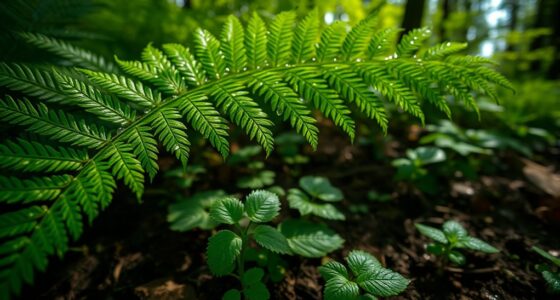Phenotypic plasticity allows plants to change their form and behavior based on environmental factors like light, water, and nutrients. When conditions shift, you can see adjustments like deeper roots or smaller leaves to conserve water or absorb more sunlight. These changes are controlled by genetic mechanisms activated by environmental signals, helping plants survive in diverse habitats. To understand more about how this natural flexibility works, keep exploring the fascinating ways plants adapt.
Key Takeaways
- Plants modify physical traits such as root depth, leaf size, or flowering time based on environmental cues.
- Environmental triggers like light, water, and nutrients activate signaling pathways that regulate gene expression.
- Gene regulation enables reversible adjustments, allowing plants to adapt their form dynamically to changing conditions.
- Genetic mechanisms predispose plants to respond flexibly, optimizing resource use and survival.
- Phenotypic plasticity enhances plant resilience by enabling form changes suited to diverse and fluctuating environments.

Phenotypic plasticity is the ability of an organism to change its physical traits or behavior in response to environmental conditions. When it comes to plants, this flexibility allows you to adapt to fluctuating environments, ensuring survival and reproductive success. The key to this adaptability lies in the interplay between genetic mechanisms and environmental triggers. Your genetic makeup contains the instructions for how you might respond to different stimuli, but it’s the environment that activates these responses. When environmental triggers, such as drought, high salinity, or varying light levels, occur, they set off a cascade of genetic adjustments that change how you grow and develop. This is not a random process; it’s a highly regulated response driven by your genes sensing specific signals from your surroundings. Understanding genetic regulation is essential to grasp how these changes are precisely controlled. At the core of phenotypic plasticity are genetic mechanisms that enable you to alter your traits. These mechanisms include gene regulation, where certain genes are turned on or off depending on the environmental cues you encounter. For example, in response to water scarcity, genes related to root growth might be activated to deepen your roots, while genes controlling leaf size might be suppressed to reduce water loss. This dynamic regulation allows you to optimize resource use and improve your chances of survival. You might also possess gene variants that predispose you to more flexible responses, giving you an advantage in unpredictable environments. These genetic mechanisms are embedded within your DNA, but their expression is often contingent on environmental triggers, making your phenotype highly adaptable. Environmental triggers are the signals from the environment that initiate these genetic responses. They can be physical factors, like light intensity or temperature, or chemical cues, such as soil nutrients or water availability. When these triggers are detected, they activate signaling pathways within your cells that lead to changes in gene expression. For instance, increased sunlight may trigger the production of more chlorophyll, helping you maximize photosynthesis. Conversely, shade might lead to elongation of stems or petioles, allowing you to reach better light. These responses are immediate and reversible, meaning you can adjust your form depending on current conditions. This flexibility is crucial for plants, which can’t move away from unfavorable environments but must instead alter their structure to cope. In essence, your ability to adapt through phenotypic plasticity hinges on a sophisticated system where genetic mechanisms are finely tuned to environmental triggers. This integration allows you to modify your physical features dynamically, enabling you to thrive in diverse and changing habitats. Understanding these processes reveals how plants are not passive organisms but active responders, constantly adjusting their form to survive and flourish amidst environmental challenges.
Frequently Asked Questions
Can Phenotypic Plasticity Occur in Animals as Well as Plants?
You might wonder if phenotypic plasticity occurs in animals too. The answer is yes; animals display this trait as well, showcasing remarkable animal adaptability. It allows them to modify traits in response to environmental changes, impacting their survival. This flexibility has significant evolutionary implications, as it can lead to faster adaptation and influence natural selection. So, both plants and animals use phenotypic plasticity to thrive amid changing environments.
How Quickly Can Plants Change Their Form in Response to Environmental Shifts?
They say, “A stitch in time saves nine,” highlighting the importance of quick action. Plants can have a rapid response to environmental shifts, often within hours or days, triggering morphological shifts like leaf size or root growth. This swift adaptation helps them survive changing conditions. While not as fast as animals, plants still exhibit remarkable flexibility, adjusting their form to optimize survival in real-time.
Are Some Plant Species More Adaptable Than Others Due to Plasticity?
You’ll find that some plant species are more adaptable because they possess stronger adaptive mechanisms driven by high genetic diversity. This diversity allows them to modify their form more effectively in response to environmental changes. These plants can quickly adjust traits like leaf size or root depth, giving them a survival advantage. So, genetic diversity enhances their phenotypic plasticity, making certain species inherently more flexible and resilient in fluctuating environments.
What Genetic Factors Influence a Plant’s Ability to Exhibit Phenotypic Plasticity?
You should understand that a plant’s ability to show phenotypic plasticity depends on genetic regulation and gene expression. Specific genes control how flexible a plant is, with variations influencing responses to environmental changes. Genes involved in hormonal pathways, signaling, and developmental processes are key. When these genes are highly responsive or adaptable, the plant can modify its form more effectively, demonstrating greater phenotypic plasticity.
How Does Phenotypic Plasticity Impact Plant Survival Under Climate Change?
You recognize that phenotypic plasticity helps plants survive climate change by allowing adaptive drought responses and increasing temperature tolerance. When environments change rapidly, this flexibility enables you to adjust growth patterns, water use, and heat resistance. As a result, you improve your chances of survival, maintain reproductive success, and better withstand stressors like droughts and heatwaves, making phenotypic plasticity a essential trait for adapting to a changing climate.
Conclusion
Imagine witnessing a plant change its form to thrive in different environments—doesn’t that make you wonder how adaptable life truly is? Phenotypic plasticity shows you how plants actively adjust their structure and function to survive, highlighting nature’s incredible resilience. As you observe these adaptations, ask yourself: wouldn’t we all benefit from such flexibility? Embracing this understanding can deepen your appreciation for nature’s ingenuity and the essential role of adaptability in our ever-changing world.










